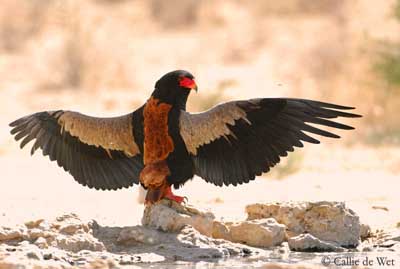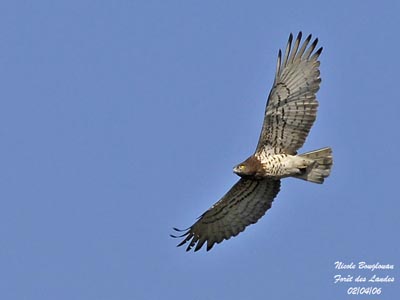
Text by Nicole Bouglouan
Photographers:
Jean Michel Fenerole
Photos d’Oiseaux
Steve Garvie
RAINBIRDER Photo galleries
Niraj V. Mistry
Photo Galleries
Callie de Wet
GALLERY
Nicole Bouglouan
PHOTOGRAPHIC RAMBLE
Sources :
HANDBOOK OF THE BIRDS OF THE WORLD Vol 2 by Josep del Hoyo-Andrew Elliot-Jordi Sargatal - Lynx Edicions - ISBN: 8487334156
BIRDS OF PREY OF AFRICA AND ITS ISLANDS by Alan and Meg Kemp - Struik Publishers - ISBN: 1770073698
GUIDE DES RAPACES DIURNES – Europe, Afrique du Nord et Moyen-Orient de Benny Génsbol – Delachaux et Niestlé – ISBN : 2603013270
BirdLife International (BirdLife International)
Snake-Eagles, Serpent-Eagles and Bateleur
These raptors form the fourth natural group within the huge family Accipitridae.
This group includes the Snake-Eagles, the Serpent-Eagles and the Bateleur. They are distributed among five genera and show rather primitive structure with bare reticulate legs as protection against the venom of the snakes which are their main food source.
The Snake-Eagles, the Serpent-Eagles and the Bateleur are highly specialized in hunting snakes. Their tarsi are protected from snake bites and venom by thick, imbricated scales.
They hunt from perches, or while soaring, watching for preys on the ground. They drop down to catch the snake from vegetation, tree or ground.

Circaetus gallicus
They can spend much time perched or on the wing and soaring. They hunt in open areas but also in dense vegetation, at forest edges, and fly from branch to branch, changing frequently of perch. But if there are any available perch, they regularly hover over the open areas in order to scan the ground beneath.
Once the prey is caught with the talons, the bird takes off and carries it while swallowing the snake head first. The snake’s head is often crushed or removed. The larger preys can stick out of the bill, and we can see the end of the reptile hanging from the bill during the flight.
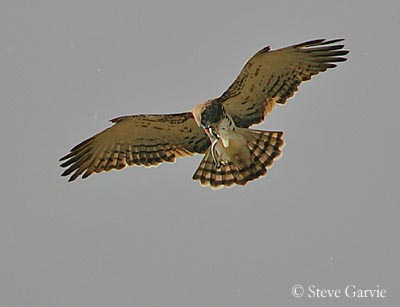
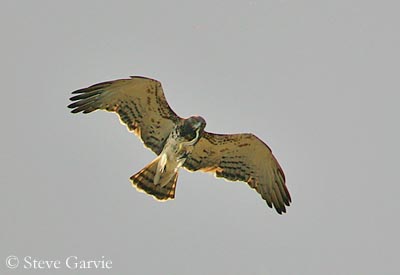
They also hunt for other reptiles such as lizards of several species, and take small vertebrates, rodents, amphibians, bats and fish, small birds. Actually, the Black-breasted Snake-Eagle(Circateus pectoralis) takes this type of preys more than the other Snake-Eagles, and takes mainly small reptiles.
The Brown Snake-eagle (Circaetus cinereus) is able to catch large and poisonous snakes, making long strikes at the prey and consuming it on the ground.
They usually hunt solitary and are secretive birds.
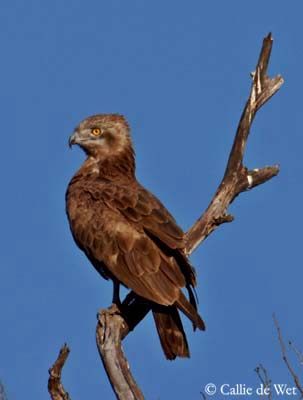
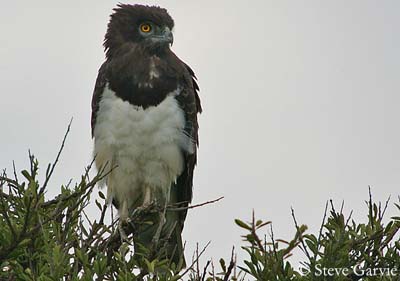
The Snake-Eagles have relatively bulky body, large head and golden-yellow eyes. Their plumage varies from pale brown to darker on the upperparts, whereas the underparts are paler and streaked. On the contrary, the Brown Snake-eagle (Circateus cinereus) has brown plumage overall, and the Western banded Snake-Eagle (Circaetus cinerascens) has pale buffy-brown underparts.
The large head is wide and enhance the golden eyes. The bill is hooked, usually with grey cere and legs, or yellow cere and legs in C. fasciolatus and C. cinerascens.
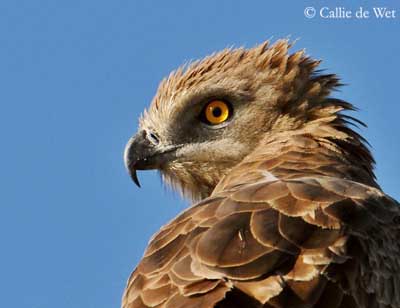
Circateus cinereus
They are more vocal prior to nesting. The Southern Banded Snake-Eagle (Circaetus fasciolatus) is a highly vocal species. Aerial displays with dives are observed. They perform undulating flights including dives with wing closed and then rising with the wings spread, while swinging round and over, and repeat this course several times.
To defend the area against intruders, they often perform determined gliding approach with the large head fully stretched out in front of the predator.
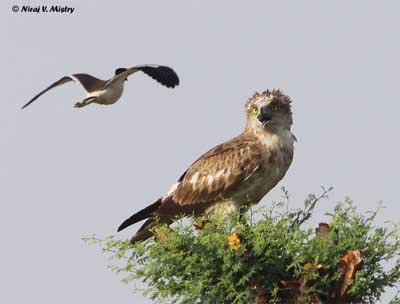
Circaetus gallicus
The Snake-Eagles nest in trees, at some metres above the ground. The nest is made with sticks and twigs, and the cup is lined with green vegetation, leaves or grass. It is relatively small compared to the size of the raptor.
One egg is laid and incubated by the female during about 45-55 days. Both parents feed and rear the young bird which fledges between 50 and 110 days after hatching according to the species.
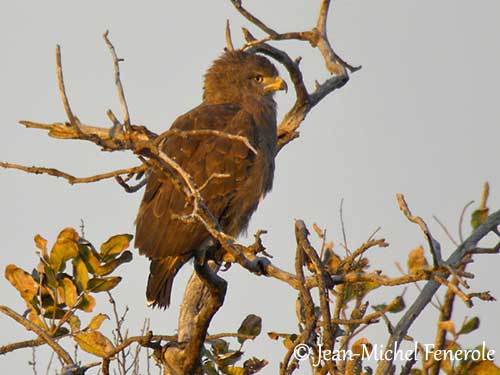
The Snake-Eagles of the Palaearctic regions are migratory and spend the winter in N tropical Africa. The eastern populations winter in Indian Subcontinent and SE Asia. The birds of India and Pakistan are sedentary.
The African Snake-Eagles’ species are mainly sedentary, only performing intra-African migrations.
Western banded Snake-Eagle - Circaetus cinerascens
The Snake-Eagles are vulnerable to destruction of the habitat and degradation and clearing of forests. They are locally common in suitable habitat, and their populations appear stable in spite of declines in 19th century.
The Southern Banded Snake-Eagle (Circaetus fasciolatus) is currently considered as Near Threatened. This species is locally common but has restricted habitat.
The other species are not globally threatened at this time, but they remain vulnerable to the changes in their habitat.
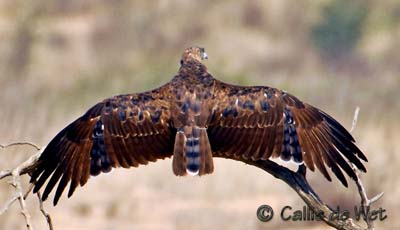
The Serpent-Eagles are small to medium-sized raptors, classified in three genera. The genus Spilornis includes six Asian species which occur from the Indian Subcontinent for the Crested Serpent-Eagle (Spilornis cheela), through Indonesia for the latter and the other species, the Great Nicobar Serpent-Eagle (Spilornis klossi), the Kinabalu Serpent-Eagle (Spilornis kinabaluensis), the Sulawesi Serpent-Eagle (Spilornis rufipectus), the Philippine Serpent-Eagle (Spilornis holospilus) and the Andaman Serpent-Eagle (Spilornis elgini).
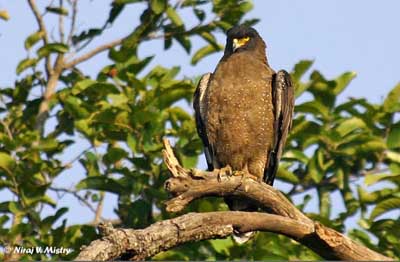
Spilornis cheela
These raptors have brown plumage on the upperparts, and paler underparts finely spotted with white. They usually show long-nape feathers forming bushy characteristic crest, probably used during the displays. The tail is conspicuously barred, very visible in flight.
The hooked blackish bill has large base and yellow cere. The eyes, legs and feet are yellow.
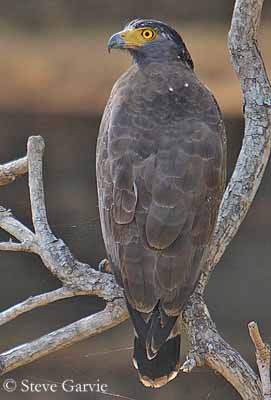
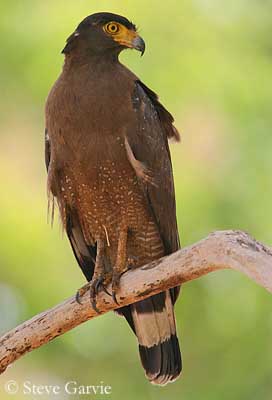
These species are usually found in forested areas with opening, at edges, and also within the forests. They can live from sea-level up to 1900 metres or higher according to the species. Some subspecies can frequent open savannahs.
These birds of prey are always difficult to see in their forested habitat, except when they are soaring above the treetops. They hunt among the trees, watching for preys from a perch, and diving down onto the snake, often arboreal ones. They catch them sometimes after several strikes given with the feet. They also take dead reptiles and hunt sometimes for small mammals and birds.
The preys are caught on the ground or in trees after brief stoop, in the typical manner of the genus.

Spilornis cheela
The Serpent-Eagles perform spectacular aerial courtship displays, with both mates doing mutual soaring over the territory and undulating flights. They also perform threat displays with arched wings upwards and raised head and tail. These displays are accompanied by loud calls.
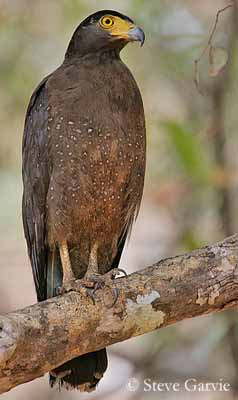
The nests are usually small compared to the size of these raptors. Except for the Crested Serpent-Eagle, the nesting behaviour is poorly known for the other species.
The female lays one egg and incubates during about 35 days or more. The chick is covered in white down and is fed by both parents.
Spilornis cheela
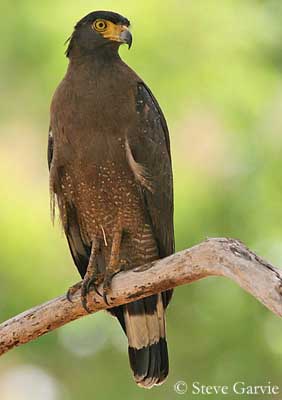
Spilornis cheela
The Serpent-Eagles are sedentary in their range. They are not globally threatened, but the statuses need more information.
The Crested Serpent-Eagle is usually widespread and even locally abundant, and the other species seem to be relatively common because they can adapt to the habitat and tolerate certain degree of habitat degradation. But the deforestation remains the main threat for all species.
The two African genera, Dryotriorchis and Eutriorchis, are relatively small raptors, with 50 and 66 centimetres long.
The Congo Serpent-Eagle (Dryotriorchis spectabilis) is fairly small with 50 cm long, but very beautiful with brighter plumage than the others. The upperparts are brown with paler and barred long, rounded tail. The underparts are spotted dark brown. The breast is bright chestnut, extending to the upper mantle, as a wide collar. The belly is white with spotted flanks and thighs. Head is brown with yellow eyes in male, brown in female. Bill is black. Cere, legs and feet are yellow.
The Madagascan Serpent-Eagle (Eutriorchis astur) is slightly longer (66 cm) than the previous. It has brown upperparts, and long, brown barred black tail, and white underparts with spotted flanks and thighs. Head is brown. Eyes, cere, legs and feet are yellow and the bill is black.
Both species show conspicuous crest erected when they are excited.
They also occur in forested areas, in rain forest. They hunt for snakes, but also chameleons and lizards for the Congo Serpent-Eagle which hunts from perch and catches the prey in the typical manner of the serpent-eagles.
However, the Madagascan Serpent-Eagle also feeds on poultry and lemurs. This one hunts on the forest floor, or flies from branch to branch within forested areas.
There is not available information about the breeding behaviour of these species. The Congo Serpent-Eagle is often heard uttering loud crowing calls.
Only one nest observed in 1997 for the Madagascan Serpent-Eagle. The nest was about 20 metres above the ground. One egg laid and about 40 days of incubation. The nesting period lasts about two months and the young is independent at 3-4 months of age.
Both species are probably sedentary in their range, with any movements recorded.
The Congo Serpent-Eagle appears to be rather common, but it is more often heard than seen.
The Madagascan Serpent-Eagle is rarely observed. Conservation and protection programs are on their way in Madagascar. This one is classified as Endangered.
Both species depend on the conservation of the rain forest.
The last “snake-eater” of this group, the Bateleur (Terathopius ecaudatus), is a very beautiful eagle with bright-coloured plumage, unusual in raptors. Several morphological features and some feeding behaviour make it closely related to the Snake-Eagles.
It has black plumage with conspicuous large greyish-white patches on the wings. Back, rump and tail are chestnut. On the underparts, the body is white and the wings show white coverts and black flight feathers. The female has almost entirely white underwing, with only black trailing edge. The large head is black. The bill is yellow with red cere and bare face. Eyes are dark brown. Legs and feet are red.
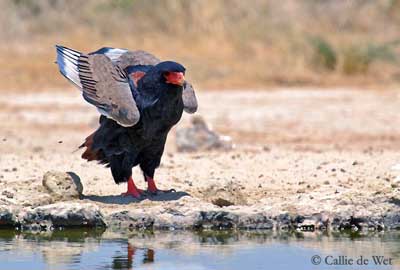
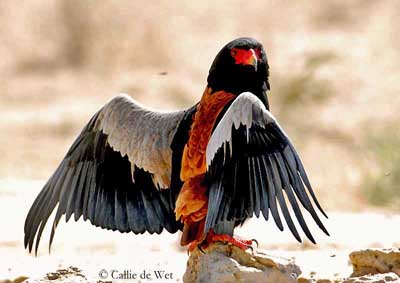
This sub-Saharan bird of prey also feeds on small mammals taken as living preys or carrion, birds, reptiles, fish, birds’ eggs, crabs and insects. Its diet is almost omnivorous. It hunts by soaring and from perch, watching for preys. It descends in a tight spiral onto the prey.
During the breeding season, they perform spectacular mating dances where the bright-coloured plumage is displayed. We can also see acrobatic display flights.
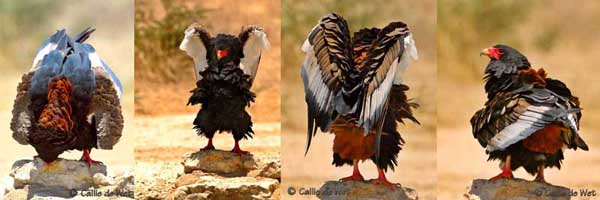
The stick nest is fairly large and built in tree fork. Only one egg is laid, and incubation lasts about 52-60 days. The chick is brown with pale head and thighs. It fledges between 93 and 190 days (this period is very variable). It depends on parents for four months more. Both adults rear the young bird.
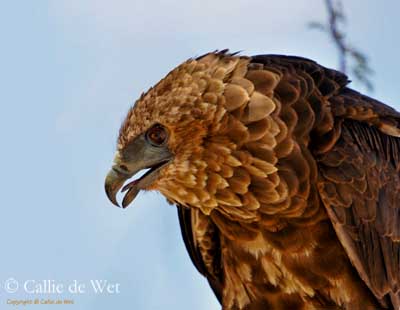
The Bateleur adult is territorial and resident, whereas the young birds become nomadic and move regularly within the African continent.
This beautiful raptor is relatively common, but its range is now restricted in many areas of South Africa, Namibia and Zimbabwe, due to poisoning and disturbances at nest-site. It remains common in nature reserves, but the species is threatened by trapping for trade, poisoning by pesticides and degradation of the habitat.
The Bateleur is classified as Near Threatened.
